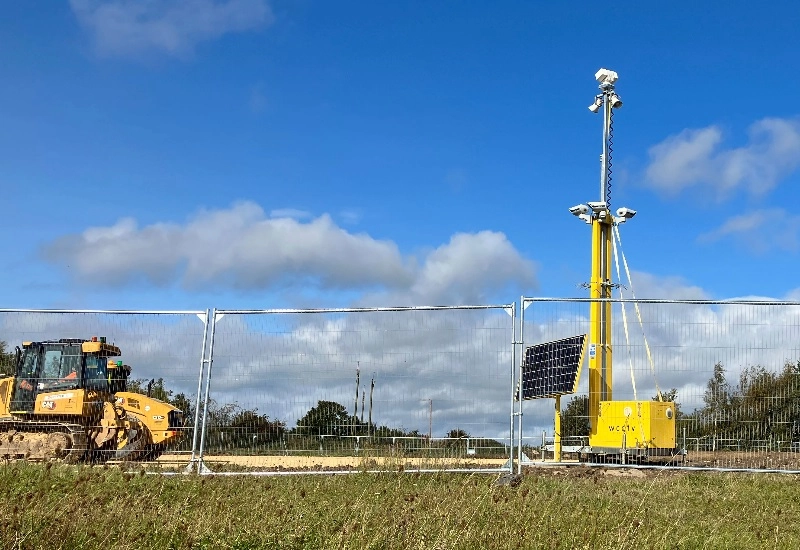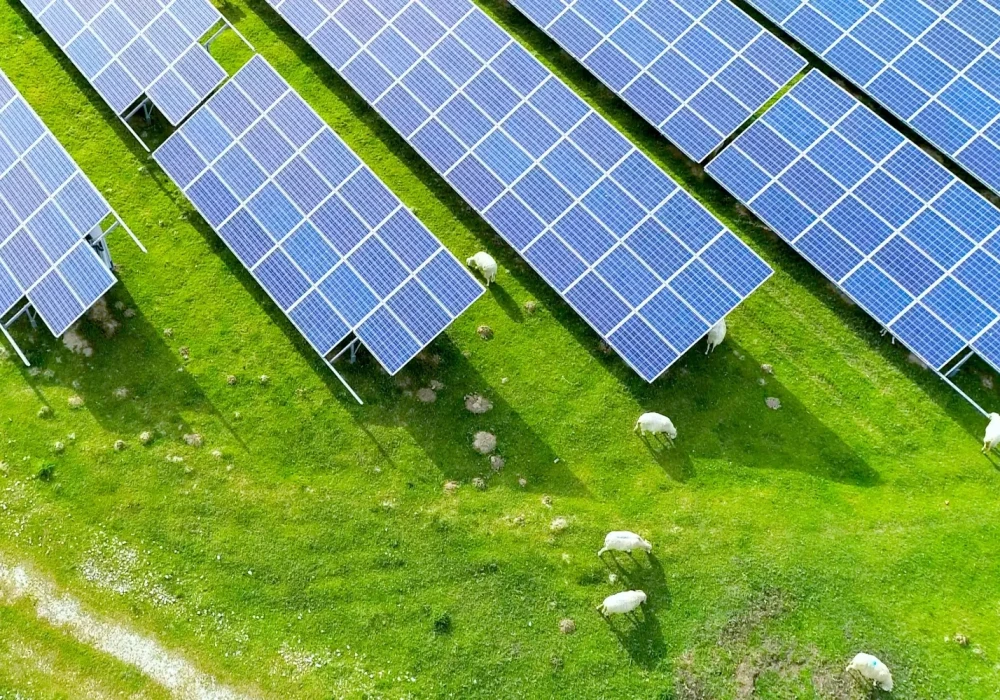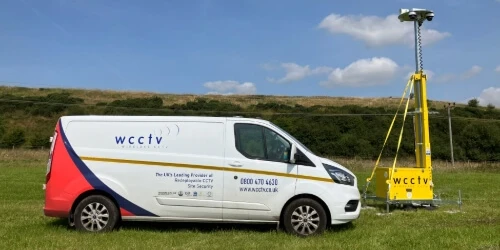The UK's solar energy sector is booming. With billions of pounds invested in new solar farms, the rapid expansion of solar infrastructure is playing a vital role in meeting the nation's Net Zero targets.
But this growth has also exposed the industry to a serious threat: solar farm theft.
This rising wave of crime doesn't just result in stolen equipment. It also causes costly delays, revenue losses and increased insurance premiums.
In this article, we explore why solar farms have become attractive targets for opportunist thieves, the real cost of solar site theft and the security systems operators need to protect their investments.
Why Are UK Solar Farms Becoming Prime Targets for Thieves?
High-value assets, remote locations and the delayed security measures are just a few reasons why solar farms in the UK are targeted by thieves.
High-value assets
Solar farms are essentially gold mines for criminals, having multiple high-value components worth up to tens of thousands of pounds on the black market. The primary targets include:
- Solar panels: Industrial-grade solar panels are expensive, ranging between £50,000 and £120,000 for 80-100 kW systems. Stolen panels, on the other hand, can generally be resold quickly at reduced prices to unsuspecting buyers. The global demand for affordable solar equipment, combined with limited traceability once panels have been removed, makes them particularly attractive to thieves.
- One reported theft from 2023 noted that 550 solar panels worth more than £100,000 were stolen from a solar site in Worcestershire.
- Copper cabling: Copper cable theft has become increasingly common due to soaring metal prices, with copper increasing by 3.88% between May and June 2025 alone. With high thermal and electrical conductivity, copper cabling is highly sought after across multiple industries, resulting in "quick money" for opportunistic criminals.
- Equipment: Inverters, solar batteries and other equipment on solar sites also have high resale value on illicit markets.
Remote locations
Solar farms require extensive open spaces to maximise energy generation and are typically situated in remote locations away from populated areas. While these isolated locations are ideal for operational efficiency, it does make solar farms more susceptible to criminal activity.
Criminals have ample time to operate undetected. While mobile patrols may visit occasionally, the nearest emergency response could be 20-30 minutes away.
Poor security measures
Many solar farms, particularly older ones, have minimal security measures beyond perimeter fencing, making them "soft targets" for thieves.
Criminal gangs have become more sophisticated when it comes to critical infrastructure security breaches, using advanced tactics to exploit these weaknesses:
- Drone surveillance: Gangs use drones to scout solar sites, pinpoint weak security and track patrol routines.
- Diversion tactics: Criminals have been known to use deliberate distractions to lure mobile security patrols away from solar sites, creating opportunities for accomplices to carry out thefts.
- Systemic operations: Instead of quick "grab-and-go" thefts, criminals now systemically remove entire strings of cabling or rows of solar equipment.
- Repeat targets: Once a solar site has been targeted, it's likely to be hit again. According to Aviva claim reports, four PV/solar farm thefts that occurred over six weeks, between December 2023 and February 2024, resulted in losses close to £250,000.
What Is the True Cost of Solar Farm Theft?
The cost of solar farm theft goes beyond replacing stolen equipment. Solar farm operators face direct losses, operational disruptions and long-term consequences that can seriously impact their Net-Zero goals.
Direct financial losses
- Replacement costs: Crimes impacting solar farms lead to direct financial losses for operators, often worth tens of thousands of pounds. For context, replacing inverters for larger installations (10-50 kW) can cost anywhere from £3,000 to £10,000 per unit.
- Repair fees: Fixing damaged infrastructure, such as cut wires, damaged mounts and solar farm perimeters, can be costly. For instance, fencing repairs can range from £110 to £150 per metre (excluding labour fees).
Operational and revenue impacts
- Loss of energy production: Stolen equipment suspends power generation, resulting in immediate revenue loss. For example, a 1 MW farm producing 4,000 kWh of solar power daily can lose around £400 for each day it is offline (at a 10p/kWh rate). Additionally, commercial operators with purchase agreements may face penalties and regulatory fines if they fail to meet contractual supply obligations.
- Downtime and delays: Sourcing replacement parts and completing repairs can take days or even weeks, further impacting revenue losses. Disruptions to the supply chain can worsen delays, particularly for new solar farms under construction, where raw materials (e.g., solar panels, copper cabling) are more accessible to thieves.
- Increased insurance premiums: This often occurs from repeated solar site theft. Insurers may also require substantial security upgrades before continuing coverage, further adding to the cost.
Indirect and long-term consequences
- Public liability risks: Operators may face public liability claims if a trespasser is injured on their solar site, even if the trespasser enters illegally. This can result in legal fees and increased public liability insurance premiums.
- Reputational damage: Solar site theft incidents can affect business relationships, community perception and investor confidence in your site's security capabilities.
- Increased security spending: The addition of reactive security measures after an incident can significantly impact your ROI.
Impact on Net Zero goals: Delays from theft slow the UK’s renewable energy progress, undermining national climate goals.
Overview of Cost Impact
| Cost Type | Description | Typical Impact/Examples |
|---|---|---|
| Direct Costs | ||
| Replacement |
Cost to buy and replace stolen equipment like solar panels, copper cabling, inverters, etc. |
|
| Repair & Labour | Cost of skilled labour and materials to repair damaged infrastructure. | Repairing cut wires, damaged mounting systems and broken perimeter fencing. |
| Operational Costs | ||
| Lost Revenue | Revenue lost from reduced or halted energy generation. |
|
| Operational Disruption | Delays in bringing the farm back online. | Weeks of downtime can impact productivity and project timelines. |
| Indirect & Long-Term Costs | ||
| Increased Insurance | Higher premiums due to frequent claims or perceived higher risk. | Insurers may impose stricter requirements or be reluctant to cover sites without robust security. |
| Legal Liability | Potential costs from injuries sustained by trespassers on the site. | Costly legal claims for personal injuries, even if the intruder was unlawful. |
| Reputational Damage | Negative impact on public perception, investor confidence and business relations. | Can affect future land agreements, investment and public support for renewable energy projects. |
| Unplanned Security Spend | Reactive investment in security measures (e.g., new CCTV, guards). | Adds unplanned operational expenses, affecting the project's overall ROI. |
| Net Zero Impact | Delay in achieving national renewable energy and climate goals. | Undermines efforts to increase renewable generation, making the transition more costly/slower. |
How to Protect Your Solar Farm From Theft
Renewable energy sites like rural solar farms require a multi-layered approach to improve security. The best security strategies integrate physical deterrents, advanced monitored CCTV surveillance and professional keyholding and alarm response services.
Physical deterrents
- Perimeter security: High-spec welded mesh fencing that meets British anti-intrusion standards is a commonly used solar farm security measure in the UK. When combined with perimeter intrusion detection (PID) systems, ANPR (automatic number plate recognition) and monitored access control, it deters thieves from entering the site.
- Security lighting: By illuminating dark corners where they might hide, well-lit perimeters and motion-sensor lights make it harder for criminals to operate undetected.
- Natural barriers: Retaining vegetation around the site perimeter creates a natural boundary around solar installations.
- Visible security: Temporary CCTV installations provide constant surveillance even in remote locations.
Advanced surveillance and monitoring
- Rapid Deployment CCTV systems: The most effective solution for solar farm security challenges. CCTV Towers provide autonomous operation using solar panels and fuel cells, making them ideal for remote sites without mains electricity. Our fully-managed CCTV Towers stand up to 6 metres tall and provide near-360° camera coverage, ensuring day-to-night protection across your site.
- Intelligent video analytics: Reduces false alarms from wildlife while focusing on genuine security threats. This is done through AI-powered analytics that monitor body temperature detection, facial recognition and movement.
- 24/7 Remote Monitoring Services: Our Remote Monitoring Services, operated by NSI Gold-accredited monitoring centres, provide real-time threat detection. When an incident occurs, our mobile keyholding and alarm response team initiates an immediate reaction (e.g., issues an audio warning, dispatches emergency services).

Protect Your Solar Investment
The cost of solar farm theft goes far beyond replacing stolen equipment, valuable materials and critical infrastructure. It can result in costly downtime, higher insurance premiums and unplanned expenses for additional security measures that impact your ROI.
With 6 regional hubs across the UK, we provide fully-managed, Mobile CCTV solutions that help prevent solar farm crime before it happens.
Solar farm security isn't a luxury anymore, but a necessity. The cost of proper solar site security is typically a fraction of what you could lose from a single solar theft incident.
Secure your solar site the smart way.



